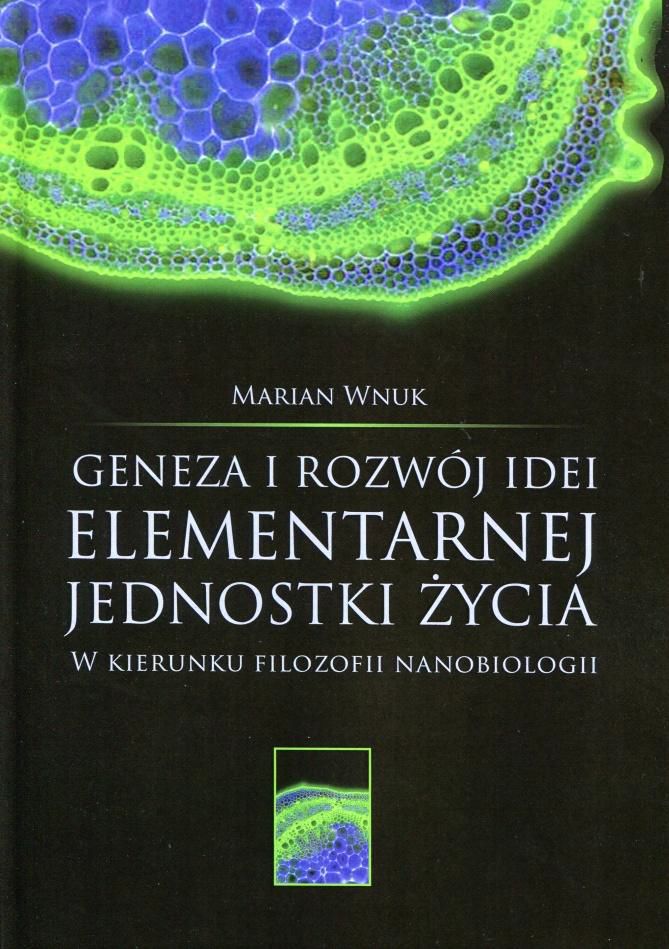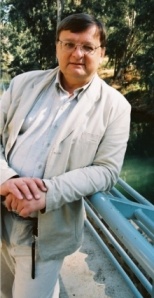 M. Wnuk: Geneza i rozwój idei elementarnej jednostki życia – W kierunku filozofii nanobiologii. Lublin: Wydawnictwo KUL; 2013, ss. 272. [The Genesis and Development of the "Elementary Unit of Life” Idea: Towards the Philosophy of Nanobiology]
M. Wnuk: Geneza i rozwój idei elementarnej jednostki życia – W kierunku filozofii nanobiologii. Lublin: Wydawnictwo KUL; 2013, ss. 272. [The Genesis and Development of the "Elementary Unit of Life” Idea: Towards the Philosophy of Nanobiology]
Introduction
The following biological and philosophical study presents the genesis and development of the idea of "the elementary unity of life". The thesis that all life is composed of some kind of indivisible, elementary units is the postulate of not just one but many philosophical doctrines, namely the "biological atomism" theory. According to this, the functioning of every living organism can be observed and explained as a result of the activity and effects of these elementary components of life — the "atoms of life". Each of them also displays all the attributes pertaining to life. Here we make an attempt to reconstruct the history of the progress of knowledge in this respect. We also undertook an analysis of scientific debates and their decisions, the language and concepts used, philosophical assumptions laying at the basis of the interpretation of certain observations and experiences, as well as an interpretation of the hypotheses and theories concerning this idea. The following study uses the historical and analytical method. The book contains six chapters.
The first chapter has a historical character and concerns the philosophical roots of the views concerning the nature of life, views which are principally based on so-called reflected popular knowledge. The historical contexts of the concept of the elementary elements of the phenomenon of life are presented (Anaxagoras, Democritus, Aristotle, St. Augustine, G. Bruno, G.W. Leibniz, R. Boyle, P.L.M. de Maupertuis, G.L.L. de Buffon, J.T. Needham, C.F. Wolff, A. van Leeuwenhoek, A. von Haller, M.F.X. Bichat, etc.). We also presented the beginnings of the creation of the cell theory as building live organisms based on empirical data (R. Hooke, R.J.J. Dutrochet, T. Schwann, M.J. Schleiden, R. Altmann, etc.). The speculative idea of the "atom of life" took very long to create. It was only when the microscope was discovered that people were able to get to know the world of the living at levels not visible to the naked human eye, and then explanations were made to explain the phenomenon of life taking into account these small dimensions. In effect, it was these new cognition tools which made it possible to also properly interpret some phenomenon concerning life and contributed to revising the dominant as of several thousand years doctrine of spontaneous generation (generatio spontanea) and creating the cell theory, in which the "cell" became known as the "minimum for life".
The second chapter is dedicated to the cell as a biological atom. People were convinced that the biological cell is the elementary unit of life, and comprises the basis for the paradigm dominant in scientific research studies for over a century and a half. This chapter analyses the most important assumptions of the cell doctrine and its aspects: the organism (L. von Bertalanffy) and reductionism (F.G.J. Henle, K. Nageli etc.), as well as the issue of the minimum genome which the minimum living cell should have. The cell doctrine states that the cell is the basic unit of life; however, the name of this unit incorporates a very diverse group, including the aspects of shape and internal structure. For example, concerning the aspect of dimensions, in the area of just prokar- yotic cells, the largest have over 10 billion time greater volume than the smallest. All present attempts to unify such diversity are to a great degree illusive. There are no are no such extremes between the atomic chemical elements as in the case of all types of biological cells. Many researches had doubts as to whether the cell as the basic unit of life is in reality the elementary unit of life: is it possibly a creation composed of units of life?
The third chapter is dedicated to objects found in the "life borderline", meaning between living beings and the inanimate. This borderline includes such creations as the nanobes, viruses, parvoviruses, prions and even some chemical molecules. These are creations of nature unusually important for the life of humans and the rest of the biosphere. The borderline between "animate-inanimate" is diverse. On the one hand, it contains objects which are still controversial in belonging to the animate world (such as nanobacteria, viruses) and on the other hand, there are objects (such as prions) which belong to the inanimate world but this is also not completely clear. Including them here or there depends on applying a more or less broad definition of living organism. The great number of such types of objects discovered might indicate a certain type of continuity between organisms and inanimate creatures.
The fourth chapter is dedicated to attempts to overcome the cell paradigm and concerns, namely, the hypotheses and theories which claim that the principle unit of life is not the cell but other biostructures, meaning some sub-cellular structures (or even beyond the cell), for example energides (J. von Sachs), biocomplexes and organoids (E. Ernst), "cell-bodies" (F. Baluska, D. Volkmann, P. W. Barlow) and nano- protoplasms (G.N. Ling).
Next, the fifth chapter is dedicated to the development of the model of the minimal living system as the elementary unit of life. These units include: coaservates (H.G. Bun- genberg de Jong, A.I. Oparin), jeewanu (K. Bahadur), microspheres (S.W. Fox), bioids (P. Deker), minimal (M,R)-systems (R. Rosen), chemotons (T. Ganti), minimal autopoietic systems (H.R. Maturana, F.J. Varela), minimal synthetic protocells (i.e. P.L. Luisi, P. Stano). The models of these units are constantly more refined. Contemporary natural sciences are close to creating a laboratory synthesis of the minimal cell, which fulfills the criteria of life, meaning a system which is at least able to work, grow and reproduce itself. In the present experimental studies, the autopoietic model is of great significance, because it prefers a particular form of physical and chemical organization processes which have as a goal organizational homeostasis. Despite this, the phenomenon of life, which had many examples to be grasped and modeled after, is extremely rich. This chapter is supplemented with the issue of alternative forms of life, which are searched for in extreme earthly and extraterrestrial environments, and this is constantly more current (astrobiology).
The final chapter completes the reconstruction of the genesis and development of the idea of the elementary unit of life, which is very contemporary and has a future, being both cognitive and pragmatic for the issue of life at the level of nano-scale processes. Studying life at the nano-scale is a new challenge, not just cognitive. Presently, the available knowledge about the living world at the nano-scale is a very passionate area of empirical research studies, and also has the ability to become a sphere of philosophical investigation. Nano-research (such as nano-biology) and nano-technology (such as nano-biotechnology) study the natural and artificial structures at so-called nano-metric dimensions (meaning from 1 to 100 nm), and this makes it possible to see nature's life processes undergoing very elementary levels of organization, the molecular and sub-molecular (meaning life processes with the participation of free charge carriers, mainly electrons as well as photons, phonons, etc.).
The course of these processes occurs in unusually short time periods. The experience obtained in these fields has already obtained great significance, as well as research on extremely small biostructures, located on the borderline between the "animate and inanimate" and in creating artificial structures — which have properties related to a natural living cell. Research on biophotons (meaning ultra-weak bioluminescence) and bioplasmas (meaning physical plasma in biosystems) can be compared to getting to know the nature of life at its nano-scale (for example, including the possibility of the existence and processing of biological information on an electro-magnetic carrier).
Biological atomism is not as mature a doctrine as physical atomism. Further models of the atom and molecular models permitted us to make precise the language of physics, chemistry and related fields, permitting more intense experimental research, and also to "reduce" the number of material substances to only over a hundred chemical elements and to efficiently manipulate them. Building the model of the "life atom" is just beginning. We do not even know if in animate nature there exists an elementary unit of life in its pure form. The very concept of "life element" is very old (for example, the Sanskrit term "atman" means the object of seeing, hearing and thinking; the equivalent of the soul). However, we do not know if this "element" is just one or are there many of them, and if there are many, how many? The ancient Greeks had in fact several phenomenons for life, with three basic concepts: zoon, bios and psyche.
A philosophical analysis concerning the nature of life was usually interwoven with the broader metaphysical (ontological), epistemological and axiological problems, meaning in the context of debates between certain viewpoints, such as for example monism - pluralism, mechanism - vitalism, reductionism - anti-reductionism, etc. Most generally speaking, we can state that life is conscious existence, which manifests itself in various forms and levels of organization. Nevertheless, this description goes too far and is impractical for experimental use. The formation of the idea of the elementary unit of life and getting to know its essence was also not free of conditions caused by these debates, which can be seen in the diverse categories of the definition of life or the forms of life. The concept of "elementariness" also developed, which is used in reference to very diverse creations or aspects studied, and these require further, more precise analyses, particularly in relation to the animate world. Therefore, it seems the issues outlined in this monograph concerning the idea of "the elementary unit of life" are cognitively attractive and will be heuristically fruitful, not only for nano-biological philosophy.



